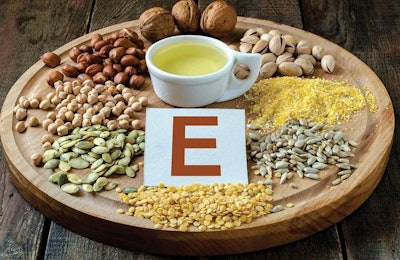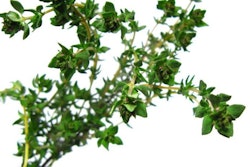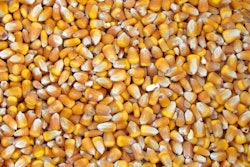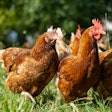
Vitamin E is an expensive vitamin, occasionally becoming very expensive. As such, most premix and feed manufacturers keep vitamin E supplementation under strict control. In my years of practice as a field nutritionist, I have seen feeds containing half the amount of vitamin E recommended by National Research Council (NRC) publications for monogastric animals.
As expected, such diets caused severe problems, hence the need for consultation. At the same time, I have also experienced extremely high levels (up to 10-fold higher than NRC), without any obvious reason or beneficial result, and with a great cost to the animal producer. There is considerable noise around the use of vitamin E, and I believe it is important to set the stage right so that the correct level of this vitamin is used, for the right diet and for the right purpose. Below are six very important aspects relating to vitamin E that every nutrition professional should keep in mind when setting dietary specifications for this expensive nutrient.
1. Antioxidant vitamin
The main, if only, role of vitamin E is that of a powerful antioxidant. Oxidation is a natural phenomenon resulting from the normal, daily metabolism within every organism. It is an unavoidable side effect for which the organism uses antioxidants to protect itself. Vitamin E is a fat-soluble vitamin, and it acts as an antioxidant within the cellular structure — mainly protecting the lipid-rich membranes from oxidative damage (degeneration). In contrast, selenium and vitamin C are working mostly as external antioxidants, operating within body fluids and inter-cellular compartments.
2. Antioxidant system
Vitamin E is part of a vast antioxidant system that involves numerous compounds. In some cases related to oxidative stress, it is necessary for both vitamin E and selenium to be deficient for a disease to appear. Such cases include exudative diathesis, liver necrosis and white muscle disease. It appears there is a sparing effect between vitamin C on the one hand, and selenium plus vitamin C on the other. Although animals produce enough vitamin C (unlike humans) to meet normal requirements, some studies have indicated beneficial effects from external supplementation. Could this be due to an undetected deficiency of vitamin E?
3. Requirements and benefits
Normal requirements for growth and maintenance are covered by the above-mentioned NRC publications. However, it has been shown that supra-nutritional levels (at least twice nutritional minimal levels) result in marked improvements in animal health and growth. For example, extra vitamin E supplementation is recommended for layers and sows that exhibit liver and kidney problems. The same is true for young animals that suffer from a low immune system status. In addition, diets with a strong oxidative potential (high levels of polyunsaturated fatty acids — PUFA, or rancid lipids in general) require extra vitamin E supplementation. Leg problems related to arthritis due to swollen joints have been addressed successfully with extra dietary vitamin E. As oxidation is a causative factor of aging, adding extra vitamin E in diets for breeding animals might prolong their productive life span. Thus, it is important to match dietary specifications with additional expected outcomes, and not only growth and maintenance.
4. Losses, natural and synthetic
Vitamin E in natural feedstuffs is variable and it is also affected by manufacturing processes. Being fat-soluble, vitamin E is associated with the lipid fraction of ingredients. As such, ingredients such as full-fat soybeans and wheat germ are rich sources. Fine milling, however, will expose lipids to environmental oxidation, which in turn will consume natural occurring vitamin E. Furthermore, vitamin E, and supplemental vitamin E in particular, are very sensitive to organic acids. As the latter becomes a mainstream ingredient in monogastric diets, it is perhaps high time to reevaluate the levels of vitamin E in such diets to prevent deficiencies.
5. Which vitamin E is best?
Vitamin E is activity expressed by tocopherols and tocotrienols. Each compound exists in several isomeric forms, with a vast difference in biological activity among the individual members within each group. There is an international system that has standardized the biological activity of vitamin E sources, under which vitamin E biological activity and requirements are expressed in IU (international units), with 1 IU corresponding to the activity of 1 mg DL-alpha-tocopheryl acetate. The alpha-tocopherol isomer is the one with the greatest nutritional importance. It abounds in green foliage and ingredients such as wheat germ, safflower oil, and sunflower oil. In contrast, gamma-tocopherol abounds in corn and soybean oil.
6. Natural antioxidants versus vitamin E
Naturally occurring antioxidants, such as certain polyphenols, are now available as extracts or part of certain specialty ingredients. These compounds exert a strong antioxidant effect that can spare or replace the role of vitamin E. Indeed, at times when vitamin E becomes extremely expensive, such additives find increased usage. There is a replacement factor (for example, x mg of such polyphenols from this source equal y IU vitamin E), but this is different for each product as not all polyphenols are the same (in fact, it is one huge and widely diverse group of compounds). In addition, research is still ongoing and remains unclear, but promising. In general, at least a minor part of vitamin E can be replaced by such products, especially when this vitamin in used at supra-nutritional levels.

















